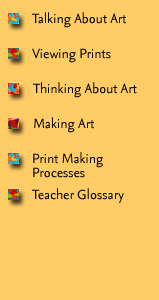
 |
||||||||
|
|
||||||||
|
|
|
|
|
|
|
|
|
|
|
|
||||||||

|
|
Home > Learning
Resources > Teacher's Packet
> Print Making
Processes > Intaglio ProcessesIntaglio ProcessesIn intaglio printmaking processes, recesses are created in a metal plate into which ink is spread for printing. Some of the ways these grooves can be created are by cutting away with hand tools or by etching with acid. The four Intaglio processes: Etching Etching is an intaglio method of printmaking. It was first developed during the sixteenth century, when it was discovered that acid could incise, or cut an image into a metal plate. An acid-resistant waxy ground is first applied to the metal plate. After the ground has dried, and etching needle is used to draw images by scratching through the ground and exposing the metal underneath. The plate is then submerged into an acid bath, which eats into the exposed areas, creating a “bite” or incision. The areas of the plate still covered by the acid resistant ground are unaffected by the acid. Once the incisions are deep enough, the plate is removed from the acid bath, and the ground is removed with a solvent. The entire plate is then inked using a dabber to force the ink into the incised lines. Then, the surface of the plate is wiped clean; however, the ink remains in the incised lines. The plate is now placed face up on the bed of what is called an etching press. A piece of dampened paper is placed over the image, and padded with a blanket. The plate is run through the ink, and the paper is forced into the lines, where is picks up the ink. Because the paper is usually larger than the plate, an indentation appears around the edge of the image. This is known as a plate mark. Aquatint Aquatint is an etching method that allows you to create both areas of solid tone and gradations of tone from white through a range of grays and black. The process involves coating the plate with resin, and etching the plate with acid. Spit bite aquatint combines spit, glue or gum arabic with the acid, in order to create softer, more watercolor like lines. The big difference between etching and aquatint is that because of the resin, you can create large areas of different tones. In order to achieve the same effect with etching, you would have to do a lot of cross hatching to rough up the plate. Direct Gravure Direct gravure is a type of etching. Using light, an image is applied to a photosensitized surface, but instead of developing with photographic chemicals, the surface is bit with acid and then printed. It is called direct gravure because even though a photosensitive surface and light are used to create the plate, no photography is used to make the image. Mezzotint Mezzotint (literally “half tone”) is a method of printmaking that was
popular during the 18th century, especially for portraiture. The prints
created are usually very small, and are engravings of tone as opposed to
engravings on line. First, a small spiked tool called a rocker is used to
make fine dots all over the entire surface of the plate, until it appears in
texture like a file, and in appearance like a rich black color. Then, the
plate is scraped and burnished to smooth out the surface to create lighter
areas. The areas that are left rough contain a greater surface texture, and
are able to physically hold onto more ink, therefore printing dark tones of
color. The areas that are smoothed out are unable to retain the ink, and
print lightly, or remain the color of the printing paper. |